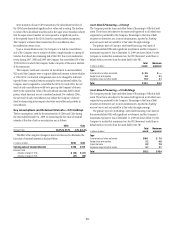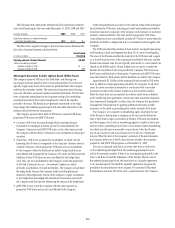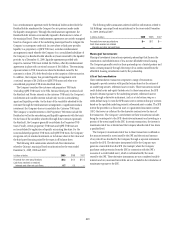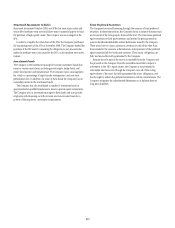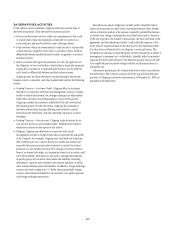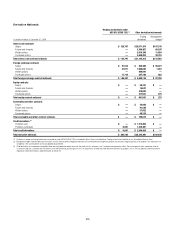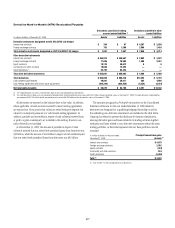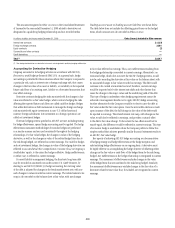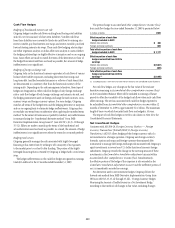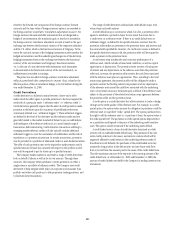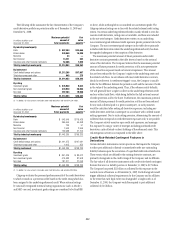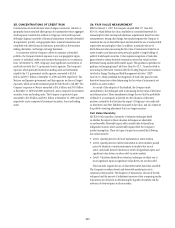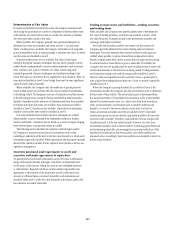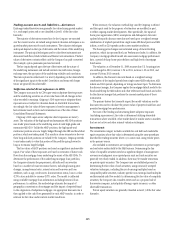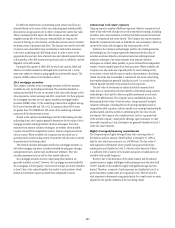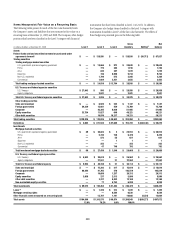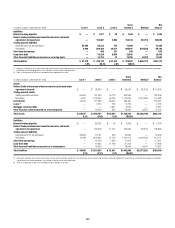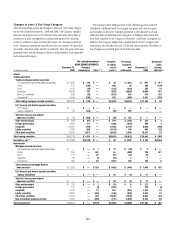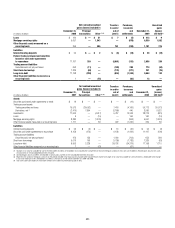Citibank 2009 Annual Report Download - page 231
Download and view the complete annual report
Please find page 231 of the 2009 Citibank annual report below. You can navigate through the pages in the report by either clicking on the pages listed below, or by using the keyword search tool below to find specific information within the annual report.221
related to the forward-rate component of the foreign-currency forward
contracts and the time-value of foreign-currency options, are recorded in
the foreign-currency Cumulative translation adjustment account. For
foreign-currency denominated debt instruments that are designated as
hedges of net investments, the translation gain or loss that is recorded in
the foreign-currency translation adjustment account is based on the spot
exchange rate between the functional currency of the respective subsidiary
and the U.S. dollar, which is the functional currency of Citigroup. To the
extent the notional amount of the hedging instrument exactly matches the
hedged net investment and the underlying exchange rate of the derivative
hedging instrument relates to the exchange rate between the functional
currency of the net investment and Citigroup’s functional currency
(or, in the case of a non-derivative debt instrument, such instrument
is denominated in the functional currency of the net investment), no
ineffectiveness is recorded in earnings.
The pretax loss recorded in foreign-currency translation adjustment
within Accumulated other comprehensive income (loss), related to the
effective portion of the net investment hedges, is $4,560 million during the
year ended December 31, 2009.
Credit Derivatives
A credit derivative is a bilateral contract between a buyer and a seller
under which the seller agrees to provide protection to the buyer against the
credit risk of a particular entity (“reference entity” or “reference credit”).
Credit derivatives generally require that the seller of credit protection make
payments to the buyer upon the occurrence of predefined credit events
(commonly referred to as “settlement triggers”). These settlement triggers
are defined by the form of the derivative and the reference credit and are
generally limited to the market standard of failure to pay on indebtedness
and bankruptcy of the reference credit and, in a more limited range of
transactions, debt restructuring. Credit derivative transactions referring to
emerging market reference credits will also typically include additional
settlement triggers to cover the acceleration of indebtedness and the risk of
repudiation or a payment moratorium. In certain transactions, protection
may be provided on a portfolio of referenced credits or asset-backed securities.
The seller of such protection may not be required to make payment until a
specified amount of losses has occurred with respect to the portfolio and/or
may only be required to pay for losses up to a specified amount.
The Company makes markets in and trades a range of credit derivatives,
both on behalf of clients as well as for its own account. Through these
contracts, the Company either purchases or writes protection on either a
single name or a portfolio of reference credits. The Company uses credit
derivatives to help mitigate credit risk in its corporate and consumer loan
portfolio and other cash positions, to take proprietary trading positions, and
to facilitate client transactions.
The range of credit derivatives sold includes credit default swaps, total
return swaps and credit options.
A credit default swap is a contract in which, for a fee, a protection seller
agrees to reimburse a protection buyer for any losses that occur due to
a credit event on a reference entity. If there is no credit default event or
settlement trigger, as defined by the specific derivative contract, then the
protection seller makes no payments to the protection buyer and receives only
the contractually specified fee. However, if a credit event occurs as defined in
the specific derivative contract sold, the protection seller will be required to
make a payment to the protection buyer.
A total return swap transfers the total economic performance of a
reference asset, which includes all associated cash flows, as well as capital
appreciation or depreciation. The protection buyer receives a floating rate
of interest and any depreciation on the reference asset from the protection
seller and, in return, the protection seller receives the cash flows associated
with the reference asset plus any appreciation. Thus, according to the total
return swap agreement, the protection seller will be obligated to make a
payment anytime the floating interest rate payment and any depreciation
of the reference asset exceed the cash flows associated with the underlying
asset. A total return swap may terminate upon a default of the reference asset
subject to the provisions of the related total return swap agreement between
the protection seller and the protection buyer.
A credit option is a credit derivative that allows investors to trade or hedge
changes in the credit quality of the reference asset. For example, in a credit
spread option, the option writer assumes the obligation to purchase or sell the
reference asset at a specified “strike” spread level. The option purchaser buys
the right to sell the reference asset to, or purchase it from, the option writer at
the strike spread level. The payments on credit spread options depend either
on a particular credit spread or the price of the underlying credit-sensitive
asset. The options usually terminate if the underlying assets default.
A credit-linked note is a form of credit derivative structured as a debt
security with an embedded credit default swap. The purchaser of the note
writes credit protection to the issuer, and receives a return which will be
negatively affected by credit events on the underlying reference credit. If
the reference entity defaults, the purchaser of the credit-linked note may
assume the long position in the debt security and any future cash flows
from it, but will lose the amount paid to the issuer of the credit-linked note.
Thus the maximum amount of the exposure is the carrying amount of the
credit-linked note. As of December 31, 2009 and December 31, 2008, the
amount of credit-linked notes held by the Company in trading inventory was
immaterial.


